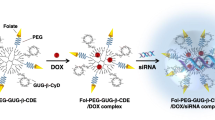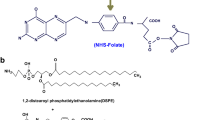Abstract
Purpose
Folate conjugated poly(propyleneimine) (PPI) dendrimer (FPPI) mediated anticancer therapy is being extensively discovered throughout the world. The present investigation was aimed at exploring the targeting potential of Melphalan loaded FPPI of different generations (MP-FPPI) for effective management of cancer.
Methods
The MP-FPPI formulations were compared for drug entrapment efficiency, in vitro release profile, toxicology, folate receptor blockage assay, cell uptake assay, stability studies, and in vivo studies.
Results
Upon increasing the dendrimer generation from fourth to fifth, the drug delivery parameters improved negligibly except the toxicological profile that improved exponentially. MTT assay in case of MCF-7 cells depicted the IC 50 values of 8 ± 0.15, 0.9 ± 0.02, 0.2 ± 0.01 and 10 ± 0.17 μM, respectively in case of MP-FPPI3, MP-FPPI4, MP-FPPI5, and free Melphalan suggesting folate based targeting to be the efficacious approach to kill cancer cells. The median survival time for tumor bearing mice treated with MP-FPPI3, MP-FPPI4, MP-FPPI5 and free drug was found to be 23, 59, 62 and 26 days, respectively.
Conclusions
The study concludes fourth generation PPI dendrimer to be superior carrier for folate based tumor targeting compared to third and fifth generation based formulations. This work is expected to provide a significant clue in the selection of “dendrimer generation” for folate mediated cancer targeting therapy.

This debut study exploring the effect of generation on the targeting potential of folate-conjugated PPI dendrimer and the outcome is expected to shed valuable information in selection of dendrimer generation.






Similar content being viewed by others
References
Kesharwani P, Tekade RK, Jain K, Jain NK. Formulation development and in vitro-in vivo assessment of fourth generation PPI dendrimer as cancer targeting vector. Nanomed (Lond) 2014 [Epub ahead of print].
Dutta T, Garg M, Jain NK. Poly (propyleneimine) dendrimer and dendrosome mediated genetic immunization against hepatitis B. Vaccine. 2008;26:3389–94.
Kesharwani P, Gajbhiye V, Jain NK. A review of nanocarriers for the delivery of small interfering RNA. Biomaterials. 2012;33:7138–50.
Jain S, Kesharwani P, Tekade RK, Jain NK. One platform comparison of solubilization potential of dendrimer with some solubilizing agents. Drug Dev Ind Pharm 2014 [Epub ahead of print].
Kesharwani P, Tekade RK, Jain K, Jain NK. Generation dependent cancer targeting potential of poly(propyleneimine) dendrimer. Biomaterials. 2014;35:5539–48.
Shao N, Su Y, Hu J, Zhang J, Zhang H, Cheng Y. Comparison of generation 3 polyamidoamine dendrimer and generation 4 polypropylenimine dendrimer on drug loading, complex structure, release behavior, and cytotoxicity. Int J Nanomedicine. 2011;6:3361–72.
Kesharwani P, Jain K, Jain NK. Dendrimer as nanocarrier for drug delivery. Prog Polym Sci. 2014;39:268–307.
Tomalia DA, Naylor AM, Goddard III WA. Starburst dendrimers: molecular-level control of size, shape, surface chemistry, topology, and flexibility from atoms to macroscopic matter. Angew Chem Int Ed. 1990;29:138–75.
Mishra V, Gupta U, Jain NK. Influence of different generations of poly(propylene imine) dendrimers on human erythrocytes. Pharmazie. 2010;65:891–5.
Shah N, Steptoe RJ, Parekh HS. Low-generation asymmetric dendrimers exhibit minimal toxicity and effectively complex DNA. J Pept Sci. 2011;17:470–8.
Kesharwani P, Tekade RK, Gajbhiye V, Jain K, Jain NK. Cancer targeting potential of some ligand-anchored poly(propylene imine) dendrimers: a comparison. Nanomedicine. 2011;7:295–304.
Kukowska-Latallo JF, Candido KA, Cao Z, Nigavekar SS, Majoros IJ, Thomas TP, et al. Nanoparticle targeting of anti-cancer drug improves therapeutic response in animalmodel of human epithelial cancer. Cancer Res. 2005;65:5317–24.
Kono K, Liu M, Frechet JM. Design of dendriticmacromolecules containing folate or methotrexate residues. Bioconjug Chem. 1999;10:1115–21.
Pinguet F, Joulia JM, Martel P, Grosse PY, Astre C, Bressolle F. High-performance liquid chromatographic assay for melphalan in human plasma. Application to pharmacokinetic studies. J Chromatogr B Biomed Appl. 1996;686:43–9.
Sashidhara KV, Rosaiah JN, Kumar A, Bid HK, Konwar R, Chattopadhyay N. Cell growth inhibitory action of an unusual labdane diterpene, 13-epi-sclareol in breast and uterine cancers in vitro. Phytother Res. 2007;21:1105–8.
Cory AH, Owen TC, Barltrop JA, Cory JG. Use of an aqueous soluble tetrazolium/formazan assay for cell growth assays in culture. Cancer Commun. 1991;3:207–12.
Patri AK, Kukowska-Latallo JF, Baker JR. Targeted drug delivery with dendrimers: comparison of the release kinetics of covalently conjugated drug and non-covalent drug inclusion complex. Adv Drug Deliv Rev. 2005;57:2203–14.
Hao H, Qi H, Ratnam M. Modulation of the folate receptor type beta gene by coordinate actions of retinoic acid receptors at activator Sp1/ets and repressor AP-1 sites. Blood. 2003;101:4551–60.
Perumal OP, Inapagolla R, Kannan S, Kannan RM. The effect of surface functionality on cellular trafficking of dendrimers. Biomaterials. 2008;29:3469–76.
Yoo HS, Park TG. Folate-receptor-targeted delivery of doxorubicin nanoaggregates stabilized by doxorubicin–PEG–folate conjugate. J Control Rel. 2004;100:247–56.
Thakur S, Tekade RK, Kesharwani P, Jain NK. The effect of polyethylene glycol spacer chain length on the tumor-targeting potential of folate-modified PPI dendrimers. J Nanoparticle Res. 2013;15:1625–40.
Kojima C, Kono K, Maruyama K, Takagishi T. Synthesis of polyamidoamine dendrimers having poly(ethylene glycol) grafts and their ability to encapsulate anticancer drugs. Bioconjug Chem. 2000;11:910–17.
Sikka PK, McMartin KE. Determination of folate transport pathways in cultured rat proximal tubule cells. Chem Biol Interact. 1998;114:15–31.
Bhadra D, Yadav AK, Bhadra S, Jain NK. Glycodendrimeric nanoparticulate carriers of primaquine phosphate for liver targeting. Int J Pharm. 2005;295:221–33.
Birdhariya B, Kesharwani P, Jain NK. Effect of surface capping on targeting potential of folate decorated poly (propylene imine) dendrimers. Drug Dev Ind Pharm. 2014:1-7 [Epub ahead of print].
Kesharwani P, Gajbhiye V, Tekade RK, Jain NK. Evaluation of dendrimer safety and efficacy through cell line studies. Curr Drug Targets. 2011;12:1478–97.
ACKNOWLEDGMENTS AND DISCLOSURES
Prashant Kesharwani acknowledges Indian Council of Medical Research (ICMR), New Delhi, India for providing Senior Research Fellowship.
Author information
Authors and Affiliations
Corresponding authors
Electronic supplementary material
Below is the link to the electronic supplementary material.
ESM 1
(DOC 136 kb)
Rights and permissions
About this article
Cite this article
Kesharwani, P., Tekade, R.K. & Jain, N.K. Generation Dependent Safety and Efficacy of Folic Acid Conjugated Dendrimer Based Anticancer Drug Formulations. Pharm Res 32, 1438–1450 (2015). https://doi.org/10.1007/s11095-014-1549-2
Received:
Accepted:
Published:
Issue Date:
DOI: https://doi.org/10.1007/s11095-014-1549-2




